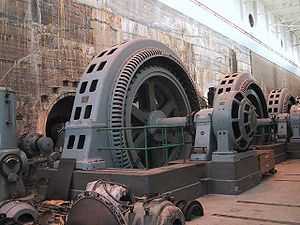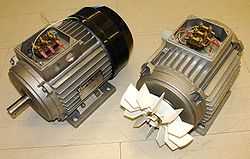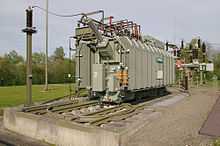Electrical machine
An electrical machine is the apparatus that converts energy in three categories: generators which convert mechanical energy to electrical energy, motors which convert electrical energy to mechanical energy, and transformers which changes the voltage level of an alternating current.
Generator

An electric generator is a device that converts mechanical energy to electrical energy. A generator forces electrons to flow through an external electrical circuit. It is somewhat analogous to a water pump, which creates a flow of water but does not create the water inside. The source of mechanical energy, the prime mover, may be a reciprocating or turbine steam engine, water falling through a turbine or waterwheel, an internal combustion engine, a wind turbine, a hand crank, compressed air or any other source of mechanical energy.
The two main parts of an electrical machine can be described in either mechanical or electrical terms. In mechanical terms, the rotor is the rotating part, and the stator is the stationary part of an electrical machine. In electrical terms, the armature is the power-producing component and the field is the magnetic field component of an electrical machine. The armature can be on either the rotor or the stator. The magnetic field can be provided by either electromagnets or permanent magnets mounted on either the rotor or the stator. Generators are classified into two types, AC generators and DC generators.
AC generator
An AC generator converts mechanical energy into alternating current electricity. Because power transferred into the field circuit is much less than power transferred into the armature circuit, AC generators nearly always have the field winding on the rotor and the armature winding on the stator.
AC generators are classified into several types.
- In an induction generator, the stator magnetic flux induces currents in the rotor. The prime mover then drives the rotor above the synchronous speed, causing the opposing rotor flux to cut the stator coils producing active current in the stator coils, thus sending power back to the electrical grid. An induction generator draws reactive power from the connected system and so cannot be an isolated source of power.
- In a Synchronous generator (alternator), the current for the magnetic field is provided by a separate DC current source.
DC generator
A DC generator produces direct current electrical energy from mechanical energy. A DC generator can operate at any speed within mechanical limits and always output a direct current waveform. Direct current generators known as dynamos work on exactly the same principles as alternators, but have a commutator on the rotating shaft which convert the alternating current produced by the armature to direct current.
Motor

An electric motor converts electrical energy into mechanical energy. The reverse process of electrical generators, most electric motors operate through interacting magnetic fields and current-carrying conductors to generate rotational force. Motors and generators have many similarities and many types of electric motors can be run as generators, and vice versa. Electric motors are found in applications as diverse as industrial fans, blowers and pumps, machine tools, household appliances, power tools, and disk drives. They may be powered by direct current or by alternating current which leads to the two main classifications: AC motors and DC motors.
AC motor
An AC motor converts alternating current into mechanical energy. It commonly consists of two basic parts, an outside stationary stator having coils supplied with alternating current to produce a rotating magnetic field, and an inside rotor attached to the output shaft that is given a torque by the rotating field. The two main types of AC motors are distinguished by the type of rotor used.
- Induction (asynchronous) motor, the rotor magnetic field is created by an induced current. The rotor must turn slightly slower (or faster) than the stator magnetic field to provide the induced current. There are three types of induction motor rotors, which are squirrel-cage rotor, wound rotor and solid core rotor.
- Synchronous motor, it does not rely on induction and so can rotate exactly at the supply frequency or sub-multiple. The magnetic field of the rotor is either generated by direct current delivered through slip rings (exciter) or by a permanent magnet.
DC motor
The brushed DC electric motor generates torque directly from DC power supplied to the motor by using internal commutation, stationary permanent magnets, and rotating electrical magnets. Brushes and springs carry the electric current from the commutator to the spinning wire windings of the rotor inside the motor. Brushless DC motors use a rotating permanent magnet in the rotor, and stationary electrical magnets on the motor housing. A motor controller converts DC to AC. This design is simpler than that of brushed motors because it eliminates the complication of transferring power from outside the motor to the spinning rotor. An example of a brushless, synchronous DC motor is a stepper motor which can divide a full rotation into a large number of steps. The motor's position can be controlled precisely without any feedback mechanism as long as the motor is carefully sized to the application.
Transformer

A transformer is a static device that converts alternating current from one voltage level to another level (higher or lower), or to the same level, without changing the frequency. A transformer transfers electrical energy from one circuit to another through inductively coupled conductors—the transformer's coils. A varying electric current in the first or primary winding creates a varying magnetic flux in the transformer's core and thus a varying magnetic field through the secondary winding. This varying magnetic field induces a varying electromotive force (EMF) or "voltage" in the secondary winding. This effect is called mutual induction.
Types of transformer
There are 2 types of transformers:
- Step-up transformer
- Step-down transformer
there are two types of transformers based on structure
1. core type
2. shell type
References
Chapman, Stephen J. 2005. Electrical Machinery Fundamentals. 4th Ed. New York: McGraw Hill.